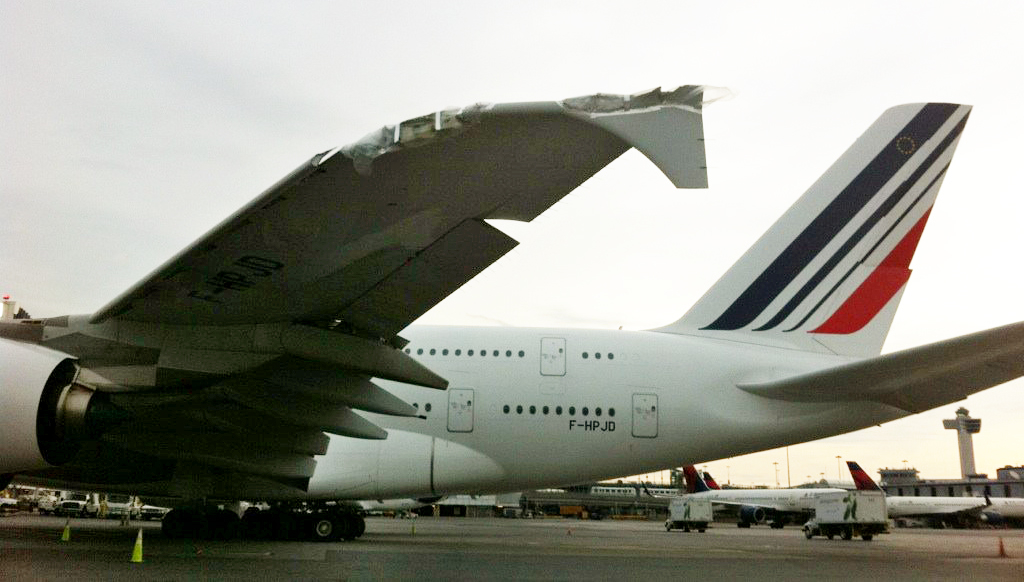A few thoughts about the taxiway collision at New York’s John F. Kennedy airport on Monday evening.
If you missed it, an Air France A380 clipped the tail of a Comair (Delta Connection) CRJ-700 regional jet. The Paris-bound A380 was headed southeast on taxiway A (“alpha”), passing behind and perpendicular to the regional jet, which was stationary and waiting to enter the parking apron at the tip of Terminal 2. The Comair pilots may or may not have been aware of the Air France behemoth as it approached, but its presence became violently clear when the giant’s left wingtip caught the much smaller CRJ by the tail and spun it nearly 90 degrees.
Has the media overblown and overhyped this incident? Naturally. And chances are you wouldn’t be hearing about it, which is to say watching it, if not for the fact it was caught on video — a video played on virtually every news channel and plastered across the World Wide Web. Just as it is doubtful that last week’s Southwest Airlines ceiling blowout would have been half the story it became without the photos and blog posts from passengers. As I wrote the other day, anybody with a mobile phone camera and an Internet connection is able to turn a minor event into a sort of digital disaster movie. For the traveling public it becomes harder to tell the difference between a minor mishap and a genuine near-catastrophe.
Am I being too sensitive? “I don’t think the real-time photos and tweets are a bad thing,” says Christine Negroni, aviation safety specialist and New York Times correspondent. “To the contrary, in each recent case — the Southwest depressurization, the A380 collision, plus the engine explosion on Qantas flight 32 — reality TV illuminated an important safety issue that otherwise might continue to be ignored. It is often the case in aviation that people judge an event by the outcome. If everything turns out OK, we assume there was nothing to worry about. But what you call ‘minor mishaps’ are like a gift, providing an opportunity to learn something without paying the price in carnage.”
She makes a good point. And, I have to admit, that was a pretty cool video. While it’s possible the footage has been sped up for effect, it shows the A380 moving at a pretty good clip, and the force of the impact is startling to behold. And although nobody was hurt, and damage to the planes was reportedly minor, it could have been worse. Planes carry fuel — lots of it — in their wings, and a worst-case scenario would have been rupture and spillage from a wing tank causing a fire or explosion.
While every fearful flier has his or her nightmare about wings falling off and turbulence flipping them upside down, in many ways it’s terra firma, not the air, that’s the more hazardous place for planes. America’s airports have expanded only slightly over the past few decades, while the number of planes they support has more than doubled. Need I remind you that history’s worst-ever aviation disaster involved two jetliners that never left the ground. And although high-speed runway collisions are the highest-level threat, taxiways and aprons, with their scrum of planes, trucks, cars and support vehicles, are the likelier spot for an accident.
(These accidents are seldom fatal for passengers, but for airport ground employees it’s another story. The International Air Transport Association describes the terminal-side apron — the “ramp,” as it’s known in aviation parlance — as “the most dangerous workplace in the world.”) What happened at JFK is under investigation.
The Airbus A380 is the largest commercial aircraft ever built (and the ugliest too, but that’s another story). From the start, concerns over the plane’s size have been about apron and taxiway space, not runway space. It requires no more runway for takeoff or landing than most other widebody jets, but presents serious challenges when it comes to maneuvering around terminals and along congested taxiways. It is only marginally longer or taller than the Boeing 747, but its wingspan is more than 60 feet wider. Many taxiways are off-limits, and A380 pilots need to be extra vigilant when operating at busy airports. The same goes for ATC ground controllers. With relatively few A380s in service, controllers are still getting familiar with their requirements.
Was the Air France crew on the correct assigned taxiway? Had they obeyed any requisite “hold short” instructions? Was the Comair plane stopped where it was supposed to be stopped? Did the controllers miss something?
One or more of those things is possible. But looking again at that video … Regardless of who or what is to blame, perhaps the most important take-away is that old, in-one-ear-and-out-the-other dictum from the flight attendants: PLEASE REMAIN SEATED WITH YOUR SEAT BELT SECURELY FASTENED UNTIL THE SEAT BELT SIGN HAS BEEN TURNED OFF.
– – – – – – – – – – – –
Do you have questions for Salon’s aviation expert? Contact Patrick Smith through his website and look for answers in a future column.

